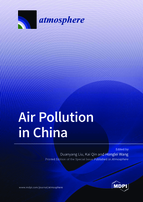Air Pollution in China
A special issue of Atmosphere (ISSN 2073-4433). This special issue belongs to the section "Air Quality".
Deadline for manuscript submissions: closed (15 May 2022) | Viewed by 69696
Special Issue Editors
Interests: transportation meteorology; low visibility; transportation meteorological observation; transportation meteorology service; fog
Special Issues, Collections and Topics in MDPI journals
Interests: aerosol; trace gases; remote sensing; lidar
Special Issues, Collections and Topics in MDPI journals
Interests: haze; new particle formation; aerosol; source apportionment
Special Issues, Collections and Topics in MDPI journals
Special Issue Information
Dear Colleagues,
In China, serious air pollution has been apparent since around the 1990s, and this is complicated due to human activities and partly due to natural factors. It is worth mentioning that local air pollution has greatly improved in the past 5 years, mainly due to the progress of institutional and technical measures since the 2010s. However, the appearance of air pollution in China is changing, as the compound pollution of photochemical pollution and aerosol pollution has been formed, and air pollution control has entered a new phase. In order to record the Chinese atmospheric environment’s development with the passage of time and to identify what we are going to face in the future, we invite papers in our latest Special Issue, “Air Pollution in China”, which will focus on air pollution trends throughout China or in each region of China over the past 30 years, the effects of countermeasures, analysis of the latest atmospheric environment, etc. Ground observations, satellite observations, and modeling approaches are welcomed.
Prof. Dr. Duanyang Liu
Prof. Dr. Kai Qin
Dr. Honglei Wang
Guest Editors
Manuscript Submission Information
Manuscripts should be submitted online at www.mdpi.com by registering and logging in to this website. Once you are registered, click here to go to the submission form. Manuscripts can be submitted until the deadline. All submissions that pass pre-check are peer-reviewed. Accepted papers will be published continuously in the journal (as soon as accepted) and will be listed together on the special issue website. Research articles, review articles as well as short communications are invited. For planned papers, a title and short abstract (about 100 words) can be sent to the Editorial Office for announcement on this website.
Submitted manuscripts should not have been published previously, nor be under consideration for publication elsewhere (except conference proceedings papers). All manuscripts are thoroughly refereed through a single-blind peer-review process. A guide for authors and other relevant information for submission of manuscripts is available on the Instructions for Authors page. Atmosphere is an international peer-reviewed open access monthly journal published by MDPI.
Please visit the Instructions for Authors page before submitting a manuscript. The Article Processing Charge (APC) for publication in this open access journal is 2400 CHF (Swiss Francs). Submitted papers should be well formatted and use good English. Authors may use MDPI's English editing service prior to publication or during author revisions.
Keywords
- air pollution prediction method in China
- air pollution observation in China
- numerical simulation of air pollution in China
- remote sensing of air pollution in China
- ozone
- new particle formation
- aerosol
- long-range transport








